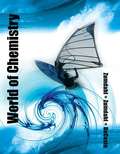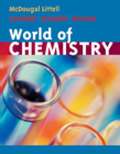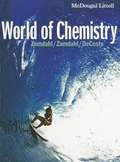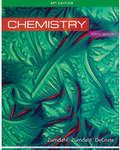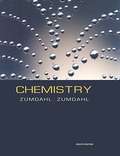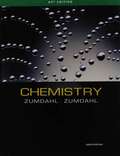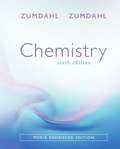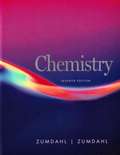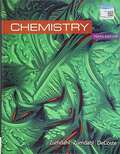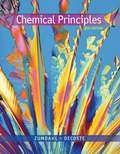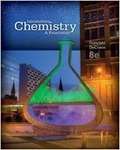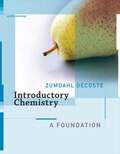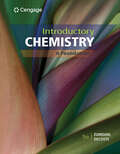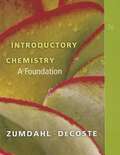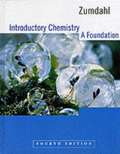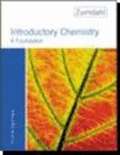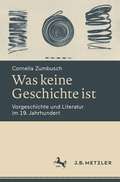- Table View
- List View
World of Chemistry: Easyplanner
by Steven S. Zumdahl Susan L. Zumdahl Donald J. DeCosteNIMAC-sourced textbook
World of Chemistry
by Steven S. Zumdahl Susan L. Zumdahl Donald J. DeCosteChemistry textbooks are written differently from non-technical textbooks. With this in mind, be aware that reading five pages in a chemistry textbook will probably take much more time than reading five pages in an English or a history textbook. If you want to understand this chemistry text, prepare to spend a great deal of time reading each section within a chapter. If you flip through this book, you will notice many examples, explanations, diagrams, charts, symbols, and photos to read, analyze, and interpret. You should read the text in each section and incorporate these visuals in your reading. You will quickly find that these visuals are very useful in helping you understand the subject matter.
World of Chemistry (Second Edition)
by Steven S. Zumdahl Susan L. Zumdahl Donald J. DecosteWorld of Chemistry presents the right balance of concepts and applications, emphasizing active learning and encouraging students to solve problems creatively.
Chemistry
by Steven S. Zumdahl Susan A. Zumdahl Donald J. DeCosteLearn the skills you need to succeed in your chemistry course with CHEMISTRY, Tenth Edition. This trusted text has helped generations of students learn to “think like chemists” and develop problem-solving skills needed to master even the most challenging problems. Clear explanations and interactive examples help you build confidence for the exams, so that you can study to understand rather than simply memorize.
World Of Chemistry
by Steven S. Zumdahl Susan A. Zumdahl Donald J. DeCosteEasy to read and accessible to all students, WORLD OF CHEMISTRY includes National Geographic images and visuals, numerous problem-solving examples, a wide range of end-of-chapter exercises, and real world applications that truly bring the "world of chemistry" together in one unique central learning resource. Offering a rigorous but understandable introduction to chemistry, this program reflects the authors' belief that chemistry is something students must construct for themselves with the help of the teacher, content support including introductions to National Geographic Explorers, and laboratory exploration. This new 4th edition has been completely redesigned to include National Geographic images, Explorers, and the incorporation of new engineering features.
Chemistry: Advanced Placement Edition
by Steven S. Zumdahl Susan A. ZumdahlCHEMISTRY allows the reader to learn chemistry basics quickly and easily by emphasizing a thoughtful approach built on problem solving. For the Eighth Edition, authors Steven and Susan Zumdahl have extended this approach by emphasizing problem-solving strategies within the Examples and throughout the text narrative. CHEMISTRY speaks directly to the reader about how to approach and solve chemical problems--to learn to think like a chemist--so that they can apply the process of problem-solving to all aspects of their lives.
Chemistry
by Steven S. Zumdahl Susan A. ZumdahlSteven and Susan Zumdahl's CHEMISTRY 8e brings together the solid pedagogy, easy-to-use media, and interactive exercises that today's instructors need for their general chemistry course. Rather than rote memorization, CHEMISTRY emphasizes a thoughtful approach built on problem-solving. For the Eighth Edition, the authors have extended this approach by emphasizing problem-solving strategies within the Examples and throughout the text narrative. The text speaks directly to the student about how to approach and solve chemical problems--to learn to think like a chemist--so that they can apply the process of problem-solving to all aspects of their lives. Students are provided with the tools to become critical thinkers: to ask questions, to apply rules and develop models, and to evaluate the outcome.
Chemistry
by Steven S. Zumdahl Susan A. ZumdahlAuthors Steven and Susan Zumdahl offer all the elements instructors need for their general chemistry course. They bring a conceptual approach to chemistry and integrate problem-solving skills throughout, helping students transition from theory to practice. A strong emphasis on models, real-world applications, and visual learning prevails throughout the text. The Seventh Edition seamlessly integrates the strengths of the Zumdahl approach through a comprehensive and interwoven print and technology program. Enhanced Sample Exercises, online homework problems, and Classroom Response System content help instructors assess conceptual understanding and problem-solving skills, while new animations and images support visual learning. In addition, Houghton Mifflin offers implementation services through our TeamUP program to help instructors and students get the most out of the text and its supplements. New! Reality Checks at the end of selected Sample Exercises prompt students to ensure that their answers are reasonable. New! The expanded art program includes new electrostatic potential maps in Chapter 8, "Bonding" that illustrate bond and molecular polarity. New! The redesigned For Review section now includes bulleted key concepts for the chapter, as well as review questions of which approximately 50% are new. New! Integrative Problems in the end-of-chapter material assess students' cumulative understanding of multiple concepts and skills presented in previous chapters. End-of-chapter questions also include collaborative Active Learning Question (formerly In-Class Discussion Questions), Exercises organized by topic, Additional Exercises not keyed by topic, integrative Challenge Problems, and comprehensive Marathon Problems. New! Algorithmically-generated Test Questions as well as Conceptual Questions are available in HM Testing, all coded by level of difficulty to allow instructors to more easily choose appropriate test items. New! Animations with assignable exercises appear on the Online Study Center and Student CD. New! HM ClassPresent v.3 includes new animations and videos as well as enhanced search functionality. Eduspace Online Learning Tool features two kinds of problems: ChemWork interactive online homework and end-of-chapter algorithmic questions with links to corresponding textbook pages and media for student reference at point of learning.
Chemistry (5th edition)
by Steven S. Zumdahl Susan A. ZumdahlThe fifth edition of Chemistry presents the concepts of chemistry in a clear, interesting, and student-friendly manner. Since visual material is especially important for learning general chemistry, which typically presents a pictorial view of chemical concepts, the illustrations representing the microscopic world of chemistry have been redone in this edition to improve their clarity and appearance. Special illustrations and color photographs integrate descriptive chemistry with chemical principles, and many new Chemical Impact features emphasize practical applications of newly learned concepts.
Chemistry (6th Edition, Media Enhanced Edition)
by Steven S. Zumdahl Susan A. ZumdahlConceptual approach to problem-solving, high-quality end-of-chapter problems, student friendly writing style and a strong emphasis on models and real-world applications are the highlights of this Chemistry 6th Edition. The new Media Enhanced Edition provides students with easy access to the media resources that support the goals of the text.
Chemistry (7th edition)
by Steven S. Zumdahl Susan A. ZumdahlAuthors bring a conceptual approach to chemistry and integrate problem-solving skills throughout, helping students transition from theory to practice. A strong emphasis on models, real-world applications, and visual learning prevails throughout the text.
Chemistry, AP* Edition
by Steven S. Zumdahl Susan A. ZumdahlThis fully updated Ninth Edition of Steven and Susan Zumdahl's CHEMISTRY brings together the solid pedagogy, easy-to-use media, and interactive exercises that today's instructors need for their general chemistry course. Rather than focusing on rote memorization, CHEMISTRY uses a thoughtful approach built on problem-solving. For the Ninth Edition, the authors have added a new emphasis on critical systematic problem solving, new critical thinking questions, and new computer-based interactive examples to help students learn how to approach and solve chemical problems--to learn to think like chemists--so that they can apply the process of problem solving to all aspects of their lives. Students are provided with the tools to become critical thinkers: to ask questions, to apply rules and develop models, and to evaluate the outcome. In addition, Steven and Susan Zumdahl crafted ChemWork, an online program included in OWL Online Web Learning to support their approach, much as an instructor would offer support during office hours. ChemWork is just one of many study aids available with CHEMISTRY that supports the hallmarks of the textbook--a strong emphasis on models, real world applications, visual learning, and independent problem solving. Available with InfoTrac Student Collections http://gocengage. com/infotrac.
Chemistry, AP* Edition
by Steven S. Zumdahl Susan A. ZumdahlThis fully updated Ninth Edition of Steven and Susan Zumdahl's CHEMISTRY brings together the solid pedagogy, easy-to-use media, and interactive exercises that today's instructors need for their general chemistry course. Rather than focusing on rote memorization, CHEMISTRY uses a thoughtful approach built on problem-solving. For the Ninth Edition, the authors have added a new emphasis on critical systematic problem solving, new critical thinking questions, and new computer-based interactive examples to help students learn how to approach and solve chemical problems--to learn to think like chemists--so that they can apply the process of problem solving to all aspects of their lives. Students are provided with the tools to become critical thinkers: to ask questions, to apply rules and develop models, and to evaluate the outcome. In addition, Steven and Susan Zumdahl crafted ChemWork, an online program included in OWL Online Web Learning to support their approach, much as an instructor would offer support during office hours. ChemWork is just one of many study aids available with CHEMISTRY that supports the hallmarks of the textbook--a strong emphasis on models, real world applications, visual learning, and independent problem solving. Available with InfoTrac Student Collections http://gocengage. com/infotrac.
Chemistry: A Foundation
by Steven S. Zumdahl Zumdahl Donald J. DeCoste Digital Consultant and Contributor Gretchen AdamsLearn the skills you need to succeed in your chemistry course with CHEMISTRY, Tenth Edition. <p><p>This trusted text has helped generations of students learn to think like chemists and develop problem-solving skills needed to master even the most challenging problems. Clear explanations and interactive examples help you build confidence for the exams, so that you can study to understand rather than simply memorize. Combined with the online resources and instant feedback in OWLv2, you'll be on your way to developing a deeper understanding of chemistry concepts and solving complex problems in all aspects of your life.
Chemical Principles (Eighth Edition)
by Steven S. Zumdahl Donald J. DecosteDevelop the qualitative, conceptual foundation you need to think like a chemist with CHEMICAL PRINCIPLES, 8e. Designed for students with solid mathematical preparation, this best-seller emphasizes models, everyday applications of chemistry, and a thoughtful, step-by-step problem-solving approach.
Introductory Chemistry: A Foundation (Eighth Edition)
by Steven S. Zumdahl Donald J. DecosteImprove the problem-solving and critical thinking skills you need for success in your introductory chemistry course and beyond with 'Introductory Chemistry'. In-text examples help you learn what questions you should be asking yourself when solving problems and 'Chemistry in Focus' boxes describe the applications of chemistry.
Introductory Chemistry: A Foundation
by Steven S. Zumdahl Donald J. DecosteChemical reactions are covered early, to capture student interest, leaving more abstract material for later chapters. The authors explain chemical concepts by starting with the basics, using symbols or diagrams, and concluding by encouraging students to test their own comprehension of the solution. This step-by-step approach helps students develop critical problem-solving skills. Also, the accessible explanations and visualizations throughout the text motivate students and engage them in the material by helping them to connect abstract chemical principles to real-life experiences. The pedagogy includes chapter-opening discussions that introduce students to relevant applications andChemistry in Focusboxes that describe everyday applications of chemistry such as artificial sweeteners, foaming chewing gum, and fake fats. Current applications appear throughout the text with easy-to-understand explanations and analogies. New! Co-author Donald DeCoste brings experience as an author and as an instructor at University of Illinois, Urbana-Champaign to this new edition. New! HM Assess within Eduspace, Houghton Mifflin's Online Learning Tool, provides a diagnostic assessment tool to test students' understanding of core concepts and track student progress. New! A Multimedia eBook within Eduspace offers a one-stop resource for students to link from textbook content to study resources, including video lessons from Thinkwell, tutorials, flashcards, and ACE quizzes. New!Chapter 10, Energy, combines all the content on energy from Chapter 3 in the Fifth Edition with material on enthalpy, Hess's Law, the difference between the quality and quantity of energy, energy resources in the world, and entropy. Exercises and models such as worked-out examples, self-check exercises, and skill development boxes support the step-by-step problem-solving method. End-of-chapter material covers key terms, a summary of important facts, questions and problems arranged in matched pairs and keyed to chapter sections, additional problems that incorporate material from multiple sections, in-class discussion questions, and "Cumulative Reviews" that tests concepts from preceding chapters. The text builds and refreshes fundamental math skills such as scientific notation, rounding, and rearranging equations. In addition, Math Tips indicated by icons throughout, help students as they perform calculations. Math Review Tutorials on the Online Study Center provide practice for critical math skills. Basic Chemistry,6/e, in paperback, includes chapters 1-16 and provides basic coverage of chemical concepts and applications through acids and bases Introductory Chemistry,6/e, available in hardcover or paperback, includes chapters 1-18 and expands coverage with the addition of equilibrium, oxidation-reduction reactions, electrochemistry, radioactivity, and nuclear energy.
Introductory Chemistry: A Foundation
by Steven S. Zumdahl Donald J. DeCosteThe Eighth Edition of Zumdahl and DeCoste's best-selling INTRODUCTORY CHEMISTRY: A FOUNDATION combines enhanced problem-solving structure with substantial pedagogy to enable students to become strong independent problem solvers in the introductory course and beyond. Capturing student interest through early coverage of chemical reactions, accessible explanations and visualizations, and an emphasis on everyday applications, the authors explain chemical concepts by starting with the basics, using symbols or diagrams, and conclude by encouraging students to test their own understanding of the solution. This step-by-step approach has already helped numerous students master chemical concepts and develop problem-solving skills. The focus on conceptual learning and motivating students by connecting chemical principles to real-life experiences in chapter-opening discussions and "Chemistry in Focus" boxes require students to think through the Example step-by-step rather than simply scan the written Example in the text as many students do.
Introductory Chemistry: A Foundation, AP® Edition
by Steven S. Zumdahl Donald J. DeCosteA bestseller among introductory texts, Zumdahl's "Introductory Chemistry series is a complete teaching system that places a unique emphasis on developing problem-solving skills with a thoughtful step-by-step approach applicable to chemistry and other disciplines. Another important goal of the series is to connect chemistry to real-life experiences, with engaging applications and colorful graphics."Basic Chemistry, 4/e, (Chapters 1-15) provides basic coverage of chemical concepts and applications through acids and bases. Inclusion of acids and bases is new."Introductory Chemistry, 4/e, (Chapters 1-18) expands coverage with the addition of equilibrium, oxidation-reduction reactions, electrochemistry, radioactivity, and nuclear energy. "Introductory Chemistry: A Foundation, 4/e (Chapters, 1-20) includes two chapters which provide a brief introduction to organic and biological chemistry.
Introductory Chemistry: A Foundation
by Steven S. Zumdahl Donald J. DeCosteSucceed in your course with INTRODUCTORY CHEMISTRY: A FOUNDATION! This best-selling text combines enhanced problem-solving structure with substantial pedagogy to help you become a successful problem solver. Early coverage of chemical reactions, accessible explanations and visualizations, and an emphasis on everyday applications facilitates understanding. The authors' step-by-step approach has already helped hundreds of thousands of student's master chemical concepts and develop strong problem-solving skills. Interactive study aids in OWLv2, such as ChemWork Problems and Adaptive Learning Activities, help students master concepts.
Introductory Chemistry: A Foundation
by Steven S. Zumdahl Donald J. DeCosteThe Sixth Edition of Introductory Chemistry: A Foundation offers unparalleled teaching and learning resources, with a robust technology package, in addition to the superior problem-solving pedagogy, engaging writing style, and strong emphasis on everyday applications that comprise the hallmarks of this best-selling text. Chemical reactions are covered early, to capture student interest, leaving more abstract material for later chapters. The authors explain chemical concepts by starting with the basics, using symbols or diagrams, and concluding by encouraging students to test their own comprehension of the solution. <p><p>This step-by-step approach helps students develop critical problem-solving skills. Also, the accessible explanations and visualizations throughout the text motivate students and engage them in the material by helping them to connect abstract chemical principles to real-life experiences. The pedagogy includes chapter-opening discussions that introduce students to relevant applications and Chemistry in Focus boxes that describe everyday applications of chemistry such as artificial sweeteners, foaming chewing gum, and fake fats. Current applications appear throughout the text with easy-to-understand explanations and analogies.
Introductory Chemistry: A Foundation
by Steven S. Zumdahl Donald J. DecosteThe Lab Manual for INTRODUCTORY CHEMISTRY: A FOUNDATION, 6th Edition, is a valuable tool designed to enhance your classroom experience. Lab activities, objectives, materials lists, step-by-step procedures, illustrations, review questions and more are all included.
Introductory Chemistry: A Foundation
by Steven S. ZumdahlA bestseller among introductory texts, Zumdahl's "Introductory Chemistry series is a complete teaching system that places a unique emphasis on developing problem-solving skills with a thoughtful step-by-step approach applicable to chemistry and other disciplines.
Introductory Chemistry: A Foundation (5th Edition)
by Steven S. ZumdahlIntroductory Chemistry presents concepts clearly using language and analogies that students can relate to and in a way that supports active learning. The In-Class Discussion Questions provide excellent material for collaborative work. The book connects chemistry to real-life experience at every opportunity, from chapter opening discussions of chemical applications to "Chemistry in Focus" features throughout the book to foster enthusiasm and real understanding as the student uses this text.
Was keine Geschichte ist: Vorgeschichte und Literatur im 19. Jahrhundert
by Cornelia ZumbuschUnter Vorgeschichte versteht man gewöhnlich die Geschichte der Menschen vor dem Einsatz schriftlicher Zeugnisse. In Bezug auf literarische Erzählungen hingegen meint Vorgeschichte das, was zwar vor dem Anfang der Geschichte geschehen ist, aber erst später erzählt wird. Ein zentraler Text für die Erforschung der Vorgeschichte sowohl in der prähistorischen Archäologie als auch in der Narratologie ist die homerische Odyssee. Am Leitfaden der Homer-Rezeption geht die Studie deshalb den Formen der Vorgeschichte im 19. Jahrhundert nach. Wie wird Vorgeschichte zum Gegenstand der Wissenschaften? Warum erzählen Romane von Goethe, Stifter und Fontane nicht nur Geschichten, sondern auch in diese eingelagerte Vorgeschichten? Und in welchem Zusammenhang steht diese Erzählform mit dem auffälligen Interesse der Literatur an Altertümern und prähistorischen Relikten?
